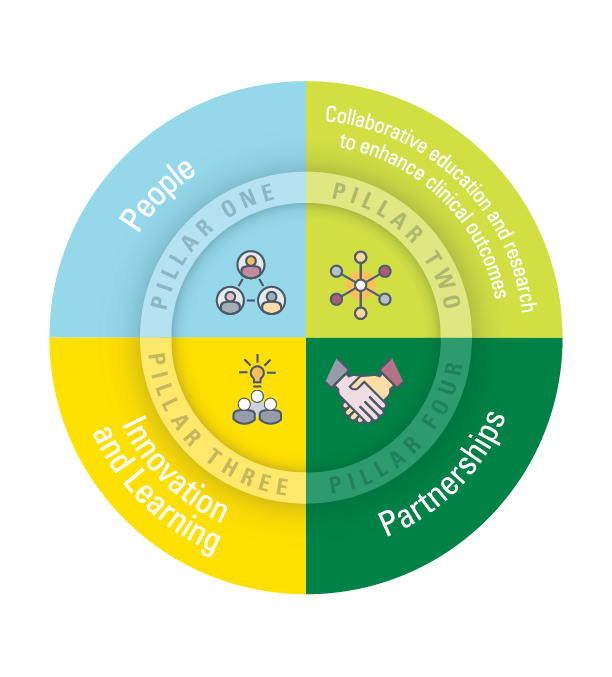Information Box Group

Our Mission
Pathology and Molecular Medicine values people and partnerships. We seek innovative solutions to clinical, educational and research challenges using a collaborative approach.

Our Vision
We aspire to be leaders of innovation, exploration and collaboration in Pathology and Molecular Medicine by integrating education, research, and best practice.

Our Five Year Report Read More
The last five years have brought substantial changes to the Department of Pathology and Molecular Medicine at McMaster University. This five-year report is the story of the new Pathology and Molecular Medicine structure, function, and goals.

Our Strategic Plan Read More
This strategic plan focuses on our collective efforts around new vision and mission statements and four pillars that will lay out a focus for our strategic framework in the years to come.
Pillars
Our core themes and values

Information Box Group
Pillar one: People
Our “people” comprise a unique integrated group of academic clinicians and biomedical scientists. This diverse cohort is the foundation upon which Pathology and Molecular Medicine’s rich history of outstanding achievements and memorable leaders is built. This pillar’s focus is the support and engagement of all our members. Based on identified priority areas – communication, mentorship, and EDI – three committees have been created to oversee, support, and provide accountability to our strategic goals. Clear and open communication is key in building trust and successful engagement. Accordingly, our Communications Committee is developing a continuous improvement model for communications. Short-term deliverables include the role-out of our new website and internal hub with a focus on clear, open, and timely communication of information to our members.
Effective mentoring programs in the clinical and research settings are proven to enhance self-development, career progression, and overall confidence. Accordingly, our Mentorship Committee is working to establish a PMM mentorship program, tailored to align with the self-identified needs of our early, mid, and late career faculty members. As powerful as the principles of equity, diversity and inclusiveness are individually, together EDI represents a comprehensive and operational strategy. PMM is committed to implementing the full scope of McMaster’s EDI initiatives. Accordingly, our Equity, Diversity, and Inclusion Committee will support us as we learn to integrate EDI strategies into PMM’s core processes. Our short-term deliverables will include the development of EDI training plans for our faculty and staff. In one year we will survey our faculty to assess our progress and if needed, recalibrate to maintain alignment with our strategic plan. In the longterm we anticipate seeing the culmination of these initiatives evidenced by improved recruitment, retention and satisfaction of faculty and staff.
Pillar two: Collaborative education and research to enhance clinical outcomes
Collaborative relationships represent mutually beneficial and well-defined opportunities in achieving a common goal. Pathology and Molecular Medicine is uniquely situated to provide impactful and significant collaborative possibilities in our education and research endeavours. The focus of this pillar is to enhance our academic and clinical collaboration leading to improved clinical care and training. Accordingly, a PMM/ HRLMP Joint Research Committee and PGME Teaching Contributions Committee have been created. The former reflects the close integration between our two organizations; the latter reflects the need to find solutions to streamline the capture of faculty teaching contributions. Both committees are working to identify priorities and develop strategies to bolster collaborative integration and enhance the work experience of our faculty.
Targeted educational training programs have been identified as an area of collaboration. To date two new clinical fellowship programs have been established, each aligning with a desired specialty. Training within this context will lead to strategic recruitment that supports our clinical mission. Additional fellowship training is under consideration. A significant potential educational initiative is the development of a McMaster-based accredited Medical Laboratory Technologist training program. Here, our skill and experience will serve the mission of HRLMP. Long-term goals will see the culmination of these initiatives evidenced by the launch of PMM Specialty Fellowships and the Medical Laboratory Technologist Program. An increase in quantifiable data collection on research project numbers, funding, accompanying publication output, and faculty retention rates will measure the efficacy of improved strategies.
Pillar three: Innovation and Learning
Innovation starts with the creativity and ingenuity of people; it is about making things better in ways that benefit everyone. As aspiring leaders of innovation, we must acknowledge it is successful pedagogical and research innovation which gives us relevancy. PMM’s ability to utilize our competencies, skills, and knowledge in these areas is one of our strengths.
Leading programs in education and research is the focus of this pillar. Our existing educational Undergraduate, Graduate and Postgraduate programs will inform our priorities and strategies. To advance this priority our department leadership in consultation with our members are developing processes to capture research and education contributions for the whole department. In parallel, a research activity metric will be established to collect this data. Assessment of all the data will help to identify and consider new ways to augment our overall research output across our different disciplines and clinical academic groups and help to identify needs for new educational programs.
Long-term goals will see the culmination of these initiatives evidenced by an increase in department-wide research activity, weighted teaching hours and potentially new programs in education.
Pillar four: Partnerships
The delivery of our PMM training programs and success of increasing our clinically relevant research activity depends on our clinical partners. A healthy relationship that speaks to both the university’s academic mission and our teaching hospital’s clinical mission is crucial in sustaining and advancing clinical education. Stakeholder satisfaction can only be achieved through effective and productive engagement underpinned by a mutual need for explicit communication, collaboration, and appropriate curriculum involvement.
Increasing our local, national, and international presence is the focus of this pillar. To advance this priority, our attention will first be centered on optimizing processes as they relate to our HRLMP partnership. Towards this end, the Clinical Workload Committee has been created. This committee in consultation with our clinical faculty is working to establish specialty-based metrics for the accurate capture of all clinical workload and scholarly contributions including external collaborations. An important part of this process will be creating strategies to address work/life balance vis-à-vis the inherent demands of clinical and academic workloads.
